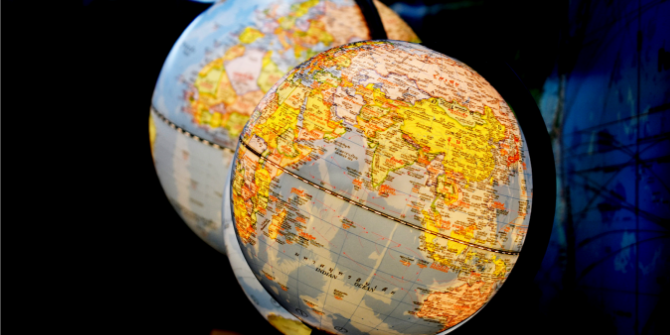Examining the academic lineages of Nobel laureates Richard S.J. Tol, shows how they form relatively closely related and self-replicating groups.
This year LSE hosted three Nobel laureates in economics, Claudia Goldin, Joseph Stiglitz and Esther Duflo. LSE Business review recently caught up with Claudia Goldin about their research on women and economics, you can read the interview here.
There is a lot of research on what does and does not work in primary education, less so on secondary education, even less on tertiary, and hardly anything at all on quaternary. This reflects their respective importance. Everyone should go to primary school, and it lays the foundation for all further education. But in an economy that is increasingly dominated by knowledge and driven by innovation, we should not shy away from asking the question how to train someone to produce, rather than reproduce, knowledge.
Like many professors, I have my theories on how best to guide someone to a PhD. Testing such hypotheses is hard because there is little to no systematic data collection. I therefore decided to start at the top: Nobel Laureates. There are few and their careers are well-documented. Collecting data on Nobelists is a task that can be managed by a sole (grantless) researcher.
I first focused on winners of Nobel Memorial Prize in economics, because that is the discipline I know. I constructed the academic family tree: Who studied with whom. The results astonished me. 82 out of 87 Nobelists share a common ancestor, often quite a recent one. Esther Duflo and Daniel McFadden are fourth generation Nobel Laureates. Both furthermore have a great-great-grandprofessor who won Nobel prices, hers in economics, his in physics.
82 out of 87 Nobelists share a common ancestor, often quite a recent one.
The central-most academic ancestor is surprising too: Karl Knies. The end of the 19th century saw the Methodenstreit ‘method wars’ about the nature of economics. Austrians argued for theory and a narrow scope, Germans for empirics and a wide range of topics. The Austrians won the battle. Economists preferred rigour over realism for a long time. But while the Austrians were busy with their elegant theories, the Germans were training young economists. A generation of young Americans studied with Professor Knies at the University of Heidelberg. They laid the foundations of the leading PhD programmes in the USA. The Germans lost the battle, but they won the war. Economics is now empirical, studying any and every topic in the social and behavioural sciences and some in the natural sciences and humanities too.
From here, I turned to the more important question: How to win a Nobel prize? You first need to be nominated. The right to nominate rests with a random sample of economics professors around the world, all economics professors in the Nordic countries, and previous Laureates – whose opinion probably carries some weight with the committee. Nominations are confidential, but there are lists of candidates. Comparing those who could have won to those who did reveals that the best strategy is to have a Nobelist among your students. In a remarkable number of cases, the student won the Nobel prize before the professor. Having studied with a Nobel laureate also improves your chances. Studying under a Nobelist reduces the probability of winning, conditional on being worthy – but presumably improves the chance of being considered.
In a remarkable number of cases, the student won the Nobel prize before the professor.
Finally, I cast the net wider and studied all four scientific Nobel prizes (there are some intriguing links to the peace prize, but for the purposes of this study they were excluded). 696 out of 727 Nobel laureates are part of the same academic family. Some of these connections go way back. Emmanuel Stupanus is the common ancestor of 668 Nobelists. Stupanus was a professor in Basel in the 17th century. He argued against empirical evidence. Joseph Thomson, who won the physics prize in 1906 for his research on conducting electricity in gas, has 227 enNobeled descendants. His professor, Lord Raleigh, won in 1904, but it was Thomson who trained a generation of ground-breaking scientists, including six Nobelists (Aston, Bohr, Born, Bragg, Davisson, Rutherford) and other famous ones, such as Robert Oppenheimer. Thomson did not just instil excellence in research in his students. He also taught them how to train the next generation.
Craig Mello, who won the 2006 medicine price for his work on RNA interference, also stands out: 51 of his ancestors won the Nobel prize. This concentration of laurels highlights a virtuous cycle: Top professors select top students and provide them with a top network and top advice in a top working environment. Those students then become top professors themselves.
This concentration of laurels highlights a virtuous cycle: Top professors select top students and provide them with a top network and top advice in a top working environment
Robert Solow is one of Mello’s ancestors. Solow won the economics prize in 1987 for his work on economic growth. Four of Solow’s students later won the economics prize – and one, Robert Horvitz, won in medicine. This is the only instance of a Nobel economist training a Nobel in another discipline. The economics Nobelists are largely isolated from the other disciplines, although there are a few with Nobel ancestry in physics and medicine.
The Nobels in the other disciplines are even more tightly connected. The broad patterns is that Nobel laureates in physics train Nobelists in physics, chemistry, and some in medicine; chemistry laureates train Nobelists in chemistry, medicine, and some in the physics; medicine Nobelists train Nobelists in medicine, some in chemistry, and few in physics.
Winners of the Nobel prize are a diverse lot. Some have few PhD students or none at all. Others have many, including many enNobeled ones. Yet others have many students, who are sound, but not exceptional. And we also see professors who were nothing special as researchers, but trained an extraordinary number of Nobelists. Returning to my original question, what makes for good postdoctoral education, these differences point to new avenues to explore and suggest patterns of best practice that might be exploited in future.
The content generated on this blog is for information purposes only. This Article gives the views and opinions of the authors and does not reflect the views and opinions of the Impact of Social Science blog (the blog), nor of the London School of Economics and Political Science. Please review our comments policy if you have any concerns on posting a comment below.
Image Credit: superjoseph on Shutterstock.







